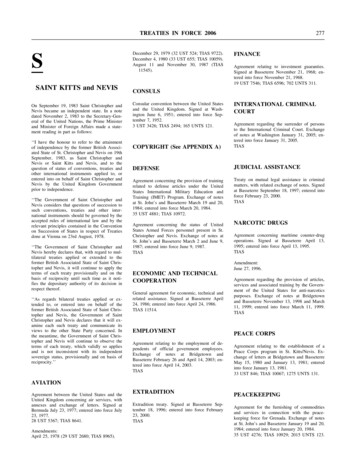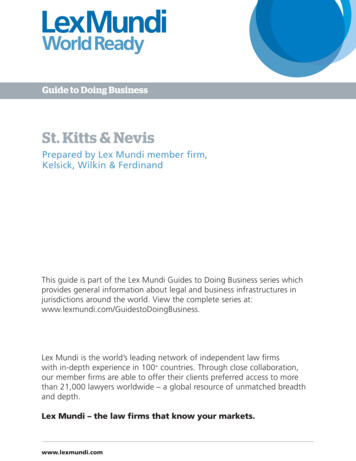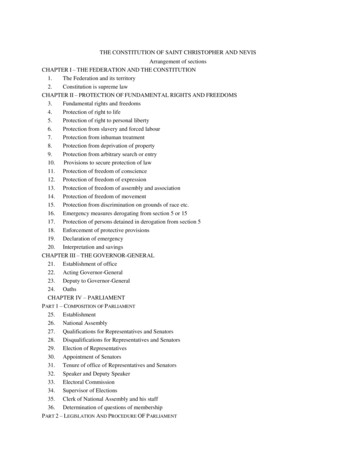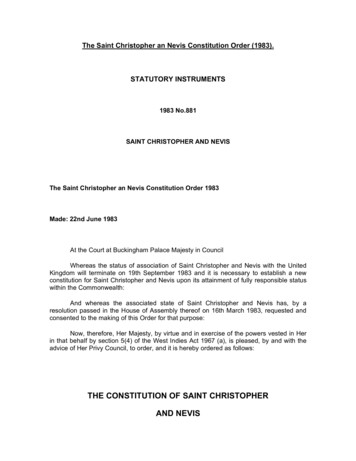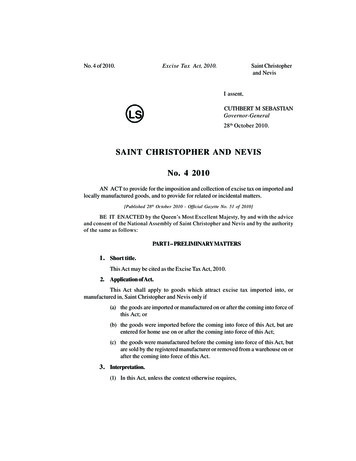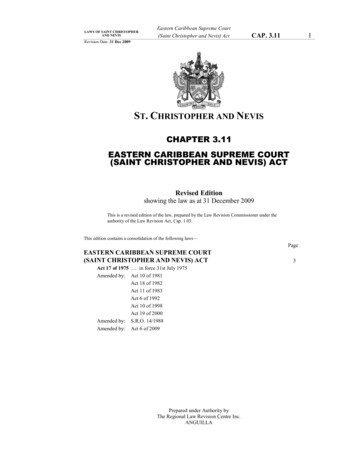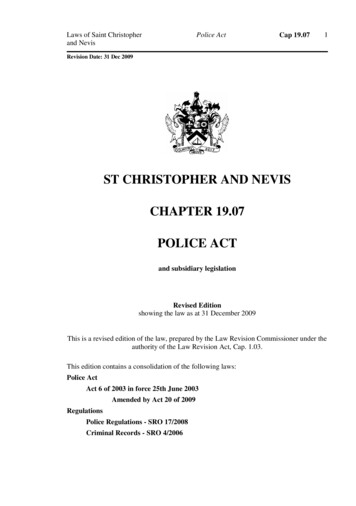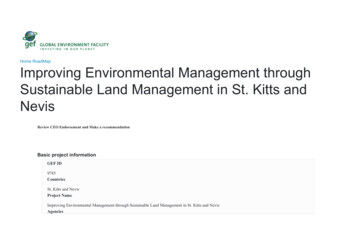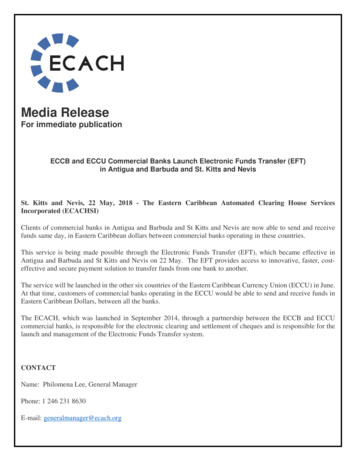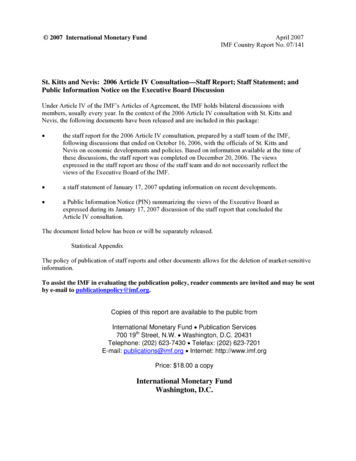
Transcription
April 2007IMF Country Report No. 07/141 2007 International Monetary Fund[Month, Day], 2001[Month, Day], 2001August 2, 2001January 29, 2001August 2, 2001St. Kitts and Nevis: 2006 Article IV Consultation—Staff Report; Staff Statement; andPublic Information Notice on the Executive Board DiscussionUnder Article IV of the IMF’s Articles of Agreement, the IMF holds bilateral discussions withmembers, usually every year. In the context of the 2006 Article IV consultation with St. Kitts andNevis, the following documents have been released and are included in this package: the staff report for the 2006 Article IV consultation, prepared by a staff team of the IMF,following discussions that ended on October 16, 2006, with the officials of St. Kitts andNevis on economic developments and policies. Based on information available at the time ofthese discussions, the staff report was completed on December 20, 2006. The viewsexpressed in the staff report are those of the staff team and do not necessarily reflect theviews of the Executive Board of the IMF. a staff statement of January 17, 2007 updating information on recent developments. a Public Information Notice (PIN) summarizing the views of the Executive Board asexpressed during its January 17, 2007 discussion of the staff report that concluded theArticle IV consultation.The document listed below has been or will be separately released.Statistical AppendixThe policy of publication of staff reports and other documents allows for the deletion of market-sensitiveinformation.To assist the IMF in evaluating the publication policy, reader comments are invited and may be sentby e-mail to publicationpolicy@imf.org.Copies of this report are available to the public fromInternational Monetary Fund Publication Services700 19th Street, N.W. Washington, D.C. 20431Telephone: (202) 623-7430 Telefax: (202) 623-7201E-mail: publications@imf.org Internet: http://www.imf.orgPrice: 18.00 a copyInternational Monetary FundWashington, D.C.
INTERNATIONAL MONETARY FUNDST. KITTS AND NEVISStaff Report for the 2006 Article IV ConsultationPrepared by the Staff Representatives for the2006 Consultation with St. Kitts and NevisApproved by Christopher Towe and Matthew FisherDecember 20, 2006Economic background and focus of discussions. St. Kitts and Nevis is a small, very open,middle-income economy with a population of about 46,000 and per capita income of overUS 9,500. The sugar industry—historically the mainstay of the economy—was closed in July2005 and discussions focused on the transition strategy, particularly on the measures neededto bring down the very high public debt burden, realize the economy’s growth potential, andto reduce vulnerabilities.Political situation. St. Kitts and Nevis form a twin-island federation with a unicameralParliament consisting of 14 representatives—8 elected in St. Kitts, 3 elected in Nevis, and3 appointees. In the National Assembly elections held in October 2004, the incumbent LaborParty was re-elected with a large majority. Premier Parry’s Nevis Reformation Party (NRP)assumed office in Nevis following elections on July 10, 2006, after 14 years in opposition.The NRP campaign emphasized improved health care, better social programs, and a lowercost of living. The new government on Nevis has taken a conciliatory approach to interisland relations.Discussions: The consultation took place during October 3–17, 2006. The team comprisedD. O. Robinson (Head), M. Mlachila, N. Mwase, and E. Tsounta (all WHD), and was joinedby staff of the ECCB and the Caribbean Development Bank (CDB). J. Fried (OED)participated in the final meetings. The team met with Prime Minister Douglas, Deputy PrimeMinister Condor, Nevis Premier Parry, other senior officials in the federal government and theNevis Island Administration, and representatives of the Opposition, trade unions, and theprivate sector.Fund relations and statistics. The last Article IV consultation was concluded onDecember 21, 2005. St. Kitts and Nevis has no outstanding Fund resources. A summary ofExecutive Board discussions is found 11.htm.Improvements are needed in several key areas to facilitate more effective surveillance,including national accounts, debt statistics, and general government statistics.
2ContentsPageExecutive Summary . 3I.Context . 4II.Recent Economic Developments and Near-Term Prospects . 6III.The Transition Strategy . 13A. Realizing Growth Potential. 13B. Achieving Fiscal and Debt Sustainability . 17IV.Reducing Risks and Vulnerabilities. 21V.Staff Appraisal. 24Boxes1.Macroeconomic Impact of Closing the Sugar Industry . 72.The Authorities’ Growth Strategy . 143.The Authorities’ Fiscal Strategy. 174.Medium-Term Scenario. 21Figures1.Economic Developments . 52.Fiscal Developments, 2003-06 . 93.Evolution of Debt, 2000–05 . 104.External Competitiveness, 1990–2006 . 115.Banking System Developments, 2000–06 . 126.Doing Business Indicators, 2006 . 157.Public Debt Sustainability: Bound Tests . 268.External Public Debt Sustainability: Bound Tests. 27Tables1.Basic Data. 282.Central Government Fiscal Operations, 2001–07. 293.Central Government Fiscal Operations, 2001–07. 304.Structure of the Public Debt, 2001–05 . 315.Balance of Payments (Active), 2001–11 . 326.Monetary Survey, 2001–06 . 337.Summary Medium-Term Projections, 2004–11 . 348.Indicators of External and Financial Vulnerability, 2001–06. 359.External Debt Sustainability Framework, 2001–11. 3610. Public Sector Debt Sustainability Framework, 2001–11. 37AnnexI. Summary of Informational Annexes . 38AppendicesI. Relations with the Fund . 39II. Relations with the World Bank Group . 42III. Relations with the Caribbean Development Bank. 45IV. Statistical Issues. 47
3EXECUTIVE SUMMARYBackgroundEconomic activity has strengthened. Growth accelerated to 4½ percent in 2006 driven byconstruction and tourism. The closure of the sugar industry in 2005 has had a limited impact ongrowth and the balance of payments, but has increased government debt and debt service costs.Large adjustments in petroleum and electricity prices created a temporary spike in inflation.Fiscal balances have improved significantly, but debt remains very high. The centralgovernment primary surplus is projected to reach 6 percent of GDP in 2006, an adjustment ofmore than 6 percent of GDP since 2004. Gross public sector debt declined only modestly to190 percent of GDP at end-2005, due to significant borrowing by public enterprises.The government has reiterated its commitment to debt reduction. A comprehensivepost-sugar adaptation strategy is being developed, supported by public outreach. The strategy isbased on sustained fiscal adjustment, asset sales, and structural reform.Policy discussionsDiscussions focused on increasing growth and restoring fiscal and debt sustainability. Thiswill require continued efforts to strengthen the business environment, improve fiscal balances,accelerate the scope and pace of government asset sales, and reduce vulnerabilities.Raising growth potential will require additional efforts in a number of areas, includingputting former sugar lands to more productive use, strengthening the investment climate,improving the tax incentive regime, and enhancing the efficiency of labor and financial markets.The authorities have announced an ambitious, but feasible, program of fiscal consolidation.The fiscal strategy includes the introduction of a VAT and the corporatization of the loss-makingelectricity sector, as well as improved prioritization of the capital budget, and refinancing ofhigh-cost debt. The authorities are also taking steps to enhance the institutional setting for fiscalpolicy.There is need to significantly improve the transparency and accountability of publicenterprises. Without proper monitoring of their financial operations, there is a risk that fiscalconsolidation undertaken by the central government could be undone.Vulnerabilities to exogenous shocks are high, but the greatest risks may stem from delays indomestic policy reforms. Even with a large fiscal adjustment and robust growth, public debt islikely to remain very high for a number of years, constraining the ability to address socialpriorities and pointing to the need for exploring options for a more rapid debt reduction andstrengthened financial sector supervision.
4I. CONTEXT1.In July 2005, the sugar industry—the historical mainstay of the economy—closed after more than 300 years. The industry had incurred substantial losses—onthe order of 3–4 percent of GDP annually in the last several years—even before theannounced further cut in preferential access to the EU market. The sugar industry hadoccupied about 9,300 acres of land (about a quarter of the land surface of St. Kitts) andemployed about 1,400 workers (6 percent of the labor force). The closure has requiredthe government to service the debt of the sugar company (29 percent of GDP).2.St. Kitts and Nevis faces the challenge of absorbing the labor and landreleased from the sugar sector and of coping with a substantial public debt burden.In consultation with the EU, a comprehensive medium-term strategy has been preparedto guide the transition of resources from sugar to more productive uses. Gross publicdebt—accumulated as a result of a series of exogenous shocks (including threehurricanes in the second half of the 1990s) and an accommodative policy stance—reached 190 percent of GDP at end-2005, creating a significant vulnerability andlimiting the scope for fiscal policy to ease the transition (Figure 1). Encouragingly, the2006 Budget Speech emphasized the need for fiscal consolidation, and announcedmedium-term fiscal and public debt targets supported by an ambitious tax reform.3.Ensuring strong social outcomes has been a high priority. The policyresponse to the large exogenous shocks during the 1990s focused on government-ledinvestment to spur growth, sustain employment, and maintain living standards. Partlyreflecting theseSt. Kitts and Nevis: Selected Social and Demographic Indicatorsefforts, St. Kitts andSt. Kitts and NevisECCUNevis is the secondHDI rank (rank out of 177 countries), 20065170Life expectancy at birth, total years), 200271.373.3highest rankedAdult literacy rate (% of people ages 15 and above), 200397.892.9Infant mortality (per 1,000 live births), 200419.015.0Caribbean nation onGDP per capita (US ), 20059,5656,023the United Nation’sAids incidences (per 100,000), 1998149Human DevelopmentSources: World Bank, WDI; United Nations, Human Development Report 2006; andcountry authorities.Index. There are,though, emergingconcerns about the spread of diabetes and hypertension.4.Discussions focused on the authorities’ transition strategy, the prioritizationof reforms, and options for reducing risks. The discussions were complemented bythe 2006 Eastern Caribbean Currency Union Regional Discussions.5.The authorities generally agreed with the staff’s analysis andrecommendations, but, as in the past, were more sanguine about the risksstemming from the debt stock. In discussions on both St Kitts and on Nevis, there wasa clear consensus on the need to reduce debt to a more manageable level, based onsustained fiscal consolidation and strong growth. The authorities emphasized that risksimplied by the high debt level were mitigated by the government’s substantial assets,particularly land. Key components of the authorities’ transition strategy—such as the taxreform—have been discussed in previous consultations, but implementation has beenheld back by the desire to build broad public consensus for the reforms.
5Figure 1. St. Kitts and Nevis: Economic Developments(In percent of GDP)20-2198019841988199219962000Sept. 11terrorist attackHurricaneLuisAverage 1990-20063.7 percentHurricaneHurricane GeorgesLennyHurricaneKlaus64FloodAverage 1980-895.6 percent108HurricaneHurricane HugoGustavReal GDP growth has declined since the eighties.122004Primary BalanceOverall rricaneLuis0-5Sept. 11terrorist attack10HurricaneLennyFiscal balances deteriorated during the mid-1990s and early 2000s, before improving strongly inrecent years.1990 1991 1992 1993 1994 1995 1996 1997 1998 1999 2000 2001 2002 2003 2004 2005 2006With additional borrowing by public enterprises, the result was a sharp increase in public debt.20018016014012010080604020Public enterprise debtCentral government debt1990 1991 1992 1993 1994 1995 1996 1997 1998 1999 2000 2001 2002 2003 2004 2005 2006Interest costs have increased significantly, in part due to a decline in concessional financing.9080706010Concessional/total external debt8Interest (right axis)64502403001990 1991 1992 1993 1994 1995 1996 1997 1998 1999 2000 2001 2002 2003 2004 2005 2006Sources: St. Kitts and Nevis authorities; World Bank Global Development Finance; and Fund staffestimates.Note: Projections for 2006.
6II. RECENT ECONOMIC DEVELOPMENTS AND NEAR-TERM PROSPECTS6.Macroeconomic outcomes have strengthened significantly in the last fewyears. Despite the closure of the sugarSt. Kitts and Nevis: Contribution to GDP Growth by Sector(In percent)industry, growth has been robust, driven by10ConstructionTourism 1/the tourism, construction, andGovernment servicesAgriculture8communications sectors, in the latter caseReal GDP Growth61reflecting liberalization in 2005 (Box 1).4Inflation accelerated in late 2005 following2the government’s decision to pass-through0some of the increase in world oil prices to-2domestic consumers by raising regulated-420022003200420052006gasoline prices and introducing an electricitySources: St. Kitts and Nevis authorities; and Fund staff2surcharge. Unemployment has remainedestimates.1/ Includes wholesale and retail trade, hotels andsubdued—at about 5 percent—despite therestaurants, airport transport and half of local transport.closure of the sugar industry.St. Kitts and Nevis: Selected Indicators, 2003–072003Real GDPCPI, end-of-yearReal effective exchangerate, (depreciation-)Prel.2004 200513Proj.2006 ominica 1/9St. Kitts and Nevis(In percent of GDP)Central governmentoverall balanceExternal currentaccount balance12(Change in percent)-1.27.32.91.7-6.9Dominica and St. Kitts and Nevis: Evolution of Gasoline Prices(EC dollars per gallon)7-3.9-25.2 -25.5-3.0-2.9-28.2 -27.56Dec-02 Apr-03 Aug-03 Dec-03 Apr-04 Aug-04 Dec-04 Apr-05 Aug-05 Dec-05 Apr-06 Aug-06Source: Eastern Caribbean Central Bank.1/ Dominica has undertaken automatic price adjustments since September 2003.Sources: St. Kitts and Nevis authorities; and Fund staff estimates.7.Central government fiscalbalances have improved by more than6 percent of GDP since 2004, yieldinglarge primary surpluses (Figure 2). Thismainly reflected increased revenueeffort—administrative reforms at bothCustoms and Inland Revenue thatsignificantly increased compliance, theelectricity surcharge, increased retail pricesfor petroleum products, and newSt. Kitts and Nevis: Selected Fiscal Indicators, 2003–0720032004Prel. Budg.2005 2006Proj.2006 2007(Central government, in percent of GDP)RevenueGrantsExpenditureCurrentOf whichInterest paymentsCapital and net 17.08.67.1Current balancePrimary balanceOverall .81.76.1-3.03.55.7-2.9. 110.0. 183.4103.7172.1Central government debtPublic sector debt118.0 119.2 117.8179.3 192.1 190.2Sources: St. Kitts and Nevis authorities; and Fund staff estimates.1National accounts data, especially on the tourism sector, are particularly weak.2A flexible pricing system allowing for full pass-through was introduced in November 2006.
7excises on alcohol and tobacco. However, noninterest expenditures were also curbed,despite the severance payments to sugar workers (2 percent of GDP in 2005 and½ percent of GDP in 2006).Box 1. St. Kitts and Nevis: Macroeconomic Impact of Closing the Sugar IndustryConsiderable long-term economic benefits are anticipated, but there will be significant transitional costs.Key benefits are likely to stem from the release of land and labor resources to more productive uses, therebyraising growth potential, as well as halting the incurrence of quasi-fiscal losses that were aggravating an alreadydifficult debt situation. Transitional costs include: The severance package for the 1,406 sugar workers of EC 27.4 million (2.3 percent of 2005 GDP).EC 22.5 million was paid during 2005 and the remainder in March 2006. The government providedeligible workers with a package of up to 104 weeks’ pay, consistent with the 1961 Severance AgreementAct. The government is servicing the debt of the St. Kitts Sugar Manufacturing Company (SSMC),increasing the central government interest bill by 1½ percent of GDP a year. The debt is in the formof a 30-year bond at 5.2 percent interest rate—about 80 percent of the debt is held by the majority stateowned National Bank, with the remainder currently held by the Development Bank (the debt is to beconsolidated with that at the former institution). The debt is secured by approximately 4,700 acres of land.Principal repayments are scheduled at EC 57 million every five years, but the National Bank retains theoption of requesting prepayment if it faces any liquidity problems. Transfers to former sugar workers are set to increase over the medium term. Under the severanceagreement, the sugar workers will receive medical care under the National Health Program, and theSSMC pensioners will be transferred to the Social Security Scheme with the guarantee that their pensionswill not be reduced. In addition, land has been allocated to workers who wanted to become farmers, and ahousing scheme is to be implemented for workers with long tenure (20 years or more) who do not ownhomes and have income levels below the poverty line. Near-term impacts on growth and foreign exchange earnings are estimated to be modest. Sugarexport proceeds had declined to an average of 2½ percent of GDP a year during 2000–04 with a limitedcontribution to value added in the economy.Transition costs may be offset by two factors: The booming economy and initial low level of unemployment has enabled the quick reabsorption ofmost workers into the labor force. A survey conducted by the Sugar Transition office in May–June2006 found that only 317 former workers were unemployed. The European Union has pledged grant support to African Caribbean Pacific (ACP) sugarproducers affected by the erosion of trade preferences. Precise amounts and modalities for receipt arestill to be finalized, but the authorities sugar transition strategy document has been reviewed and approvedby the EU.8.Nonetheless, substantial borrowing by public entities resulted in the publicdebt/GDP ratio falling only modestly during 2005 (Figure 3). Public entities—such asthe Port Authority and various land development companies—contracted an estimated11 percent of GDP in new loans during 2004–05. The gross financing needs of the
8government have been met by increased reliance on domestic financing—the overdraftfacility at the state-owned National Bank surged to almost 20 percent of GDP bymid-2006.9.The current account deficit remains very large (25 percent of GDP in 2005),but has been mainly financed by foreign direct investment, and competitivenessappears to be improving. The pickup in tourism receipts was offset by the higher cost ofoil imports, a strong rebound in non-oil imports reflecting the construction boom, and thecessation of sugar exports.10.Available data point to a strong improvement in competitiveness in recentyears (Figure 4). The real exchange rate has depreciated sharply with the depreciation ofthe U.S. dollar and is now at its lowest level in more than 15 years. Tourism receipts haveincreased and St. Kitts and Nevis’s share in both the ECCU and Caribbean tourismmarkets has risen. While tourism prospects are sensitive to both price and nonpricefactors, the strong interest from investors in a number of new projects suggests theabsence of a competitiveness concern.11.Consistent with growth in economic activity, private credit has rebounded.During 2004–05, private credit grew by 8 percent a year, and is projected to increase bymore than 10 percent in 2006, with the largest increases in real estate, household, andagricultural sectors.12.Prudential indicators point to a strengthening of the banking sector, withrisks concentrated in locally-incorporated banks. Locally-incorporated banks havesubstantial exposures to the government—particularly at the National Bank which holdsabout 60 percent of deposits in the banking system and is the largest indigenous bank inthe ECCU. System-wide NPLs declined, though largely due to the acceleration in creditgrowth. Capital adequacy ratios are well above prudential guidelines, but have to beinterpreted with care due to the low levels of provisions (Figure 5).13.Progress on structural reforms has been slow. The authorities have developed acomprehensive strategy for dealing with the transition from sugar, that may help tounlock grants from the EU, but this first required extensive consultations withstakeholders. Privatization of public entities has been particularly sluggish, with littleachieved in the last ten years.
9Figure 2. St. Kitts and Nevis: Fiscal Developments, 2003–06(In percent of GDP, central government)The fiscal position improved from early2004.8.reflecting a contraction in spending andsome improvement in revenues.386Primary mary spending (excl.severance payments)33-8Overall balance-102003200420052006322003Revenue growth reflected strengthenedtax administration.201816 Tax on international trade and transactions1412Income taxes10864 Tax on domestic goods and consumption202003200420052006The fall in primary spending reflectsbetter expenditure control.1614121086420-220039.5200420052006However, as debt has risen, interestcosts have though electricity and closure of thesugar industry have affected expenditure.11Wages1098Goods and services76Capital spending54Current transfers3Net lending2102004200520062003200420052006Sources: ECCB; and Fund staff estimates.
10Figure 3. St. Kitts and Nevis: Evolution of Debt, 2000–05(In percent of GDP, central government)140120100806040200. principally via overdrafts, andloans and advances.Reliance on domestic debt hasincreased.75ExternalDomestic6045301502000 2001 2002 2003 2004 200560OverdraftGovernment securitiesLoans and advances2000 2001 2002 2003 2004 2005.while external debt is fromcommercial lateral40Public enterprise borrowing has driventhe recent increase in debt levels.2002000 2001 2002 2003 2004 2005St. Kitts GovernmentPublic enterprisesNevis Island Administration2000 2001 2002 2003 2004 2005Gross public debt is among the highest in the world.200Public Sector Debt in Highly-Indebted Emerging MarketCountries, end 2005(In percent of GDP)1601208040St.KittsandLe Nevb isJa anm oG ai nAnrcetigna auadan Do Eg ad m yptStBa ini.Vrb cainudcent Ar Be aan ge lizd nt eG inBa re arb ns.aTu dosrkeU Bra yru zS gu ilPht. L ayuBa illip ciaPha a inem na sa mIn s, T ado heTh nesiaC ila aol noM mb dal iaaTrM ysiinaSeidxad urin icoan Ec amd ua eTo dba orgo021017514010570350Net public debt excluding social security assets is significantlylower but still high.In percent of GDPNetGross20002001200220032004Sources: ECCB; Ministry of Finance; World Bank; and Fund staff estimates.2005
11Figure 4. St. Kitts and Nevis: External Competitiveness, 1990–2006A sharp depreciation of the REER since2002 has boosted competitivenes.but the government wage bill has continued togrow faster than the rest of the ased real effectiveexchange rate(index 2000 100) 1/199419982002Average wage(private and public)100601990200650(in percent of GDP)40199330199920022005(in percent of GDP)40Exports of goods andnonfactor services1996.which was enabled by higher inflows of FDIin the hotel sector.A buoyant services sector has reversed thedeclining trend in exports.50GDPCentral governmentwage billTourism receipts3020201010Exports of goods0Foreign direct investment01990199319961999200220051990.and a more competitive position of thetourism sector.1301201996199920022005.which allowed St. Kitts and Nevis to gainmarket share in the Caribbean tourist market.16Customer-based real effective exchange rate(index 2000 100)1/12100100.7Share of ECCU stay-overarrivals(in percent, left scale)141109019930.60.5801990199419982002Share ofCaribbean arrivals(in percent, right scale)8Competitor-based real effective exchange rate(index 2000 100) 1/ 2/6200619901993199619990.40.320022005Sources: ECCB; Caribbean Tourism Organization; St. Kitts and Nevis authorities; and Fund staff calculations.1/ An increase (decrease) indicates an appreciation (depreciation).2/ The spike in the competitor-based real exchange rate in 2002–03 was largely caused by the real effectivedepreciation and subsequent appreciation of the Dominican Republic’s peso.
12Figure 5. St. Kitts and Nevis: Banking System Developments, 2000– 06(in percent)Gross public sector exposure isconcentrated in local banks.50Ratio to total depositsRatio to total assets504030201004030201002000 2001 2002 2003 2004 20052000 2001 2002 2003 2004 2005 Sep06Locally-incorporated banksForeign bank branchesLocally-incorporated banksForeign bank branchesCredit to the public sector has risen.Ratio to total assets304030201020002001200220032004Public sector creditPrivate sector creditForeign assetsProvisioning is lower in locallyincorporated banks.Ratio to NPLs7060504030201002000 2001 2002 2003 2004 2005 Sep06Locally-incorporated banksForeign bank branchesECCU averageUnsatisfactory asset ratios have beenfalling. 1/252015105020002005Capital to risk-weighted assetsRatio to total assets5080Public sector deposits, mainly fromsocial security, tend to benefit localbanks.20012002 2003 2004 2005 Sep06Locally-incorporated banksForeign bank branchesECCU averageCapital adequacy ratios are well aboveprudential norms.504030201002000 2001 2002 2003 2004 2005 Sep06Locally-incorporated banksECCU averageSource: ECCB.1/ Unsatisfactory assets include nonperforming loans, credits, and overdrafts.
13III. THE TRANSITION STRATEGY14.The authorities have formulated a comprehensive strategy to transition fromsugar to a sustainable growth path, while ensuring fiscal and debt sustainability.The strategy was the focal point for National Consultations held in October 2006. Thereare two key pillars: Growth driven by structu
2005 and discussions focused on the transition strategy, particularly on the measures needed . Minister Condor, Nevis Premier Parry, other senior officials in the federal government and the . a comprehensive medium-term strategy has been prepared to guide the transition of resources from sugar to more productive uses. Gross public
